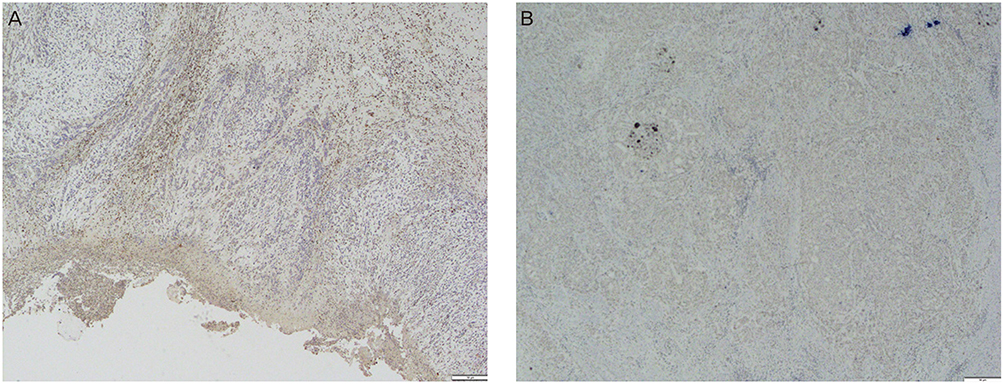Obstet Gynecol Sci.
2015 Mar;58(2):112-116. 10.5468/ogs.2015.58.2.112.
Characteristics of hereditary nonpolyposis colorectal cancer patients with double primary cancers in endometrium and colorectum
- Affiliations
-
- 1Department of Obstetrics and Gynecology, Seoul National University College of Medicine, Seoul, Korea. yookyung@snu.ac.kr
- 2Department of Laboratory Medicine, Seoul National University College of Medicine, Seoul, Korea.
- KMID: 2314034
- DOI: http://doi.org/10.5468/ogs.2015.58.2.112
Abstract
OBJECTIVE
The hereditary nonpolyposis colorectal cancer is inherited syndrome characterized by the development of cancers in various organ system; these includes colorectum, endometrium, and less frequently, small bowel, stomach, urinary tract, ovaries, and brain. We aimed to investigate the clinicopathologic characteristics of hereditary nonpolyposis colorectal cancer patients who had both endometrial and colorectal cancers.
METHODS
Between January 2004 and December 2013, 12 women diagnosed with endometrial and colorectal cancers in a single institution were included in this analysis. For these patients, clinical and molecular findings were analyzed retrospectively.
RESULTS
All 12 women undertook microsatellite instability analysis, and 9 (75%) were confirmed of having microsatellite instability-high. Among 9 cases with immunohistochemical staining for MLH1 and MSH2, 6 were positive for the loss of mismatch repair protein. Mutational analyses for MLH1 and MSH2 were performed in 3 out of 12 patients; all of them showed germline mutation.
CONCLUSION
This study suggests that there is a genetic background in patients with double primary malignancies in their endometrium and colorectum when analyzed with microsatellite instability studies, immunohistochemistry staining, and mutation studies. This finding supports the necessity of re-defining the high-risk groups in endometrial cancers clinically. This will also help diagnose malignancies in such patients in early stages, as well as counsel other family members.
MeSH Terms
Figure
Reference
-
1. National Cancer Information Center. Annual report of cancer statistics in Korea in 2011 [Internet]. Goyang: National Cancer Information Center;2013. cited 2015 Jan 27. Available from: http://www.cancer.go.kr/ebook/84/PC/84.html.2. Peltomaki P, Vasen H. Mutations associated with HNPCC predisposition: update of ICG-HNPCC/INSiGHT mutation database. Dis Markers. 2004; 20:269–276.3. Aarnio M, Sankila R, Pukkala E, Salovaara R, Aaltonen LA, de la Chapelle A, et al. Cancer risk in mutation carriers of DNA-mismatch-repair genes. Int J Cancer. 1999; 81:214–218.4. Rodriguez-Bigas MA, Boland CR, Hamilton SR, Henson DE, Jass JR, Khan PM, et al. A National Cancer Institute Workshop on Hereditary Nonpolyposis Colorectal Cancer Syndrome: meeting highlights and Bethesda guidelines. J Natl Cancer Inst. 1997; 89:1758–1762.5. Vasen HF, Watson P, Mecklin JP, Lynch HT. New clinical criteria for hereditary nonpolyposis colorectal cancer (HNPCC, Lynch syndrome) proposed by the International Collaborative group on HNPCC. Gastroenterology. 1999; 116:1453–1456.6. Loukola A, Eklin K, Laiho P, Salovaara R, Kristo P, Jarvinen H, et al. Microsatellite marker analysis in screening for hereditary nonpolyposis colorectal cancer (HNPCC). Cancer Res. 2001; 61:4545–4549.7. Shi SR, Key ME, Kalra KL. Antigen retrieval in formalin-fixed, paraffin-embedded tissues: an enhancement method for immunohistochemical staining based on microwave oven heating of tissue sections. J Histochem Cytochem. 1991; 39:741–748.8. Hewitson TD, Wigg B, Becker GJ. Tissue preparation for histochemistry: fixation, embedding, and antigen retrieval for light microscopy. Methods Mol Biol. 2010; 611:3–18.9. Shi SR, Liu C, Pootrakul L, Tang L, Young A, Chen R, et al. Evaluation of the value of frozen tissue section used as "gold standard" for immunohistochemistry. Am J Clin Pathol. 2008; 129:358–366.10. Shin KH, Shin JH, Kim JH, Park JG. Mutational analysis of promoters of mismatch repair genes hMSH2 and hMLH1 in hereditary nonpolyposis colorectal cancer and early onset colorectal cancer patients: identification of three novel germ-line mutations in promoter of the hMSH2 gene. Cancer Res. 2002; 62:38–42.11. Park JG, Vasen HF, Park YJ, Park KJ, Peltomaki P, de Leon MP, et al. Suspected HNPCC and Amsterdam criteria II: evaluation of mutation detection rate, an international collaborative study. Int J Colorectal Dis. 2002; 17:109–114.12. Banno K, Susumu N, Yanokura M, Hirao T, Iwata T, Hirasawa A, et al. Association of HNPCC and endometrial cancers. Int J Clin Oncol. 2004; 9:262–269.13. Lim MC, Seo SS, Kang S, Seong MW, Lee BY, Park SY. Hereditary non-polyposis colorectal cancer/Lynch syndrome in Korean patients with endometrial cancer. Jpn J Clin Oncol. 2010; 40:1121–1127.14. Boland CR, Koi M, Chang DK, Carethers JM. The biochemical basis of microsatellite instability and abnormal immunohistochemistry and clinical behavior in Lynch syndrome: from bench to bedside. Fam Cancer. 2008; 7:41–52.15. Lu KH, Schorge JO, Rodabaugh KJ, Daniels MS, Sun CC, Soliman PT, et al. Prospective determination of prevalence of lynch syndrome in young women with endometrial cancer. J Clin Oncol. 2007; 25:5158–5164.
- Full Text Links
- Actions
-
Cited
- CITED
-
- Close
- Share
- Similar articles
-
- Hereditary Colorectal Cancer
- Jejunal Adenocarcinoma as Part of Metachronous Triple Primary Cancers of the Digestive Tract in Patient with Hereditary Nonpolyposis Colorectal Cancer
- Hereditary Nonpolyposis Colorectal Cancer
- Hereditary Nonpolyposis Colorectal Cancer
- Clinical analysis of hereditary nonpolyposis colorectal cancer


